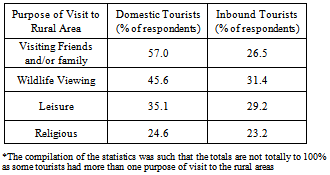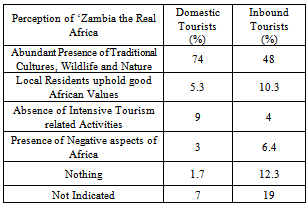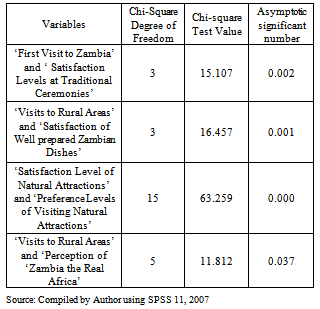-
Paper Information
- Next Paper
- Previous Paper
- Paper Submission
-
Journal Information
- About This Journal
- Editorial Board
- Current Issue
- Archive
- Author Guidelines
- Contact Us
American Journal of Tourism Management
p-ISSN: 2326-0637 e-ISSN: 2326-0645
2013; 2(A): 10-25
doi:10.5923/s.tourism.201304.02
Tourism Development Potential of the Northern Province of Zambia
Thomas Kweku Taylor, Chikondi Banda-Thole
Department of Urban and Regional Planning, School of Built Environment, Copperbelt University
Correspondence to: Chikondi Banda-Thole, Department of Urban and Regional Planning, School of Built Environment, Copperbelt University.
| Email: |  |
Copyright © 2012 Scientific & Academic Publishing. All Rights Reserved.
Tourism in most developing countries especially in sub-Saharan Africa has been promoted by tourism development agencies with very little attention being focused on the roles of rural communities in potential tourist areas. The observed trend in the last decade of international tourism development processes is that, numerous concepts on tourism have evolved based on the needs and expectations of tourists. This perception has culminated in the evolution of new tourism concepts and ideologies such as rural tourism, food tourism, eco-tourism, cultural tourism and agricultural tourism. The needs and expectations of tourists in both developed and developing countries are not the same. There are geographical attributes that influence potential tourists’ needs and expectations. This paper highlights the potentialities and opportunities for the promotion of tourism in the Northern Province of Zambia and applies some of the principles and characteristics enshrined in both the rural and eco tourism concepts towards evolving a strategic rural development framework for the promotion of sustainable rural development activities within the large territorial rural region of Northern Province of Zambia.
Keywords: Needs, Expectations, Geographical Attributes, Potentialities, Opportunities
Cite this paper: Thomas Kweku Taylor, Chikondi Banda-Thole, Tourism Development Potential of the Northern Province of Zambia, American Journal of Tourism Management, Vol. 2 No. A, 2013, pp. 10-25. doi: 10.5923/s.tourism.201304.02.
Article Outline
1. Introduction
- It is a known fact that, numerous development concepts, theories and approaches have been evolved to promote rural development. However, they have failed to yield the expected results especially in sub-Saharan Africa. One of the reasons is that, these theories are not indigenously evolved. For instance, theories such as the integrated rural development, selective spatial closure, agropolitan development concept, the market town concept were all evolved based on the experiences and needs of the people of South East Asia. The other reason is that, governments and policy makers including development planners have failed to diversify in their development strategies. For instance, on rural development and agriculture in Zambia, the Sixth National Development Plan[1] states that:“In order to reduce the high poverty levels in the rural areas and promote rural development, focus will be on stimulating agriculture productivity and promotion of agro-businesses.... High poverty levels are most prevalent in rural areas where the majority of households are dependent on agricultural activities. Investments particularly in agriculture infrastructure and rural finance offer effective means to make a significant impact on poverty levels.”[2]
1.1. Tourism and Rural Development in Zambia
- In Zambia, the tourism sector has always been perceived as a potential generator of substantial foreign exchange. However, very little effort has been made to diversify the economy. After attaining independence in 1964, the Zambian Government has made tireless efforts to promote rural development in order to curb rural-urban migration which was resulting in economic and population distribution imbalances. Efforts were also made to reduce dependence on copper production as the mainstay of the economy.The economic development strategy employed to promote rural development placed emphasis on agricultural development. The approach adopted the balanced growth strategy propounded by Hirschman[3]. The importance attached to the theory of balanced economic growth as highlighted by Ollawa[4] and also stated in the Second National Development Plan (SNDP) is to continue the building up of the country’s economic and social infrastructure while at the same time laying the foundation for a more balanced economic development of the country [5]. Ollawa[6,7] disclosed that, the success of the balanced growth approach is dependent on the existence of certain structural prerequisites including the capacity of the bureaucratic structures for moving or administering the required resources. To date, Zambia has not managed to provide the structural prerequisites needed to foster rural development. The turning point was in the late 1980s when the United National Independence Party Government under the leadership of Kenneth Kaunda was subjected to engage in structural adjustments because the country recorded negative economic growth. The most recent Central Statistical Office (CSO) figures reveal that rural poverty rates remain substantially high at 80% whilst urban poverty rates are reported to have declined from 49% in 1991 to 34% in 2006[8]. Poverty in the Northern Province has fluctuated over time, and latest statistics reveal an increase by 4%[9]. This area also records the lowest life expectancy index, in comparison to the other provinces, and is amongst the four provinces with the lowest Income Index[10].
 | Figure 1. Percentage Trends in Rural and Urban Poverty Rates in Zambia |
2. The Concepts of Tourism and Sustainable Tourism
- Tourism is a complex phenomenon covering all movements of people outside their own community for all different purposes except migration or regular daily work. It is not a single industry but a movement of people and a demand force[24]. In this paper, we perceive tourism as a dynamic activity. Due to its dynamic nature, it is continuously evolving and undergoing modifications mirroring the changing face of tourism development, the activities engaged in by tourists, and the impact not only on economic activities overall but, also on the environment, infrastructure, and the natural historical, and cultural heritage[25]. As a concept, we perceive it as defined by Olorunfemi[26] as the activities of persons travelling to and staying in places outside their usual environment for not more than one consecutive year for leisure, business and other purposes not related with exercise of an activity remunerated from within the place visited.On the contrary, sustainable tourism is defined by the Federation of Nature and National Parks[27], as….."All forms of tourism development, management and activity that maintain the environmental, social and economic integrity and well-being of natural, built and cultural resources in perpetuity". A publication by the Tourism Concern and the World Wide Fund for Nature defines sustainable tourism as a phenomenon which….."operates within natural capacities for the regeneration and future productivity of natural resources; recognises the contribution that people and communities, customs and lifestyles, make to the tourism experience; accepts that these people must have an equitable share in the economic benefits of tourism; and is guided by the wishes of local people and communities in the host areas"[28]. Sustainability contributes to both human well-being and is also in harmony with the natural environment”.
3. Meaning of Rural Development
- Rural development is a process which leads to a rise in the capacity of rural people to control their environment which results from more extensive use of the benefits which ensure such control[29]. Rural development is affected by many factors, including economic development, humanitarian attitudes, environment, social values and knowledge[30]. Sustainable rural development raises living standards, to allow people to reach their human potential, to enjoy lives of dignity, and to ensure the welfare of present and future generations[31].
4. Instances of Sustainable Tourism and Rural Development in Sub-Saharan Africa
- Advocating for the promotion of sustainable tourism and rural development in the Northern Province of Zambia is not an innovation that has no reference to other tourism oriented economies in the world. Tourism as a human activity is dynamic due to the needs and aspirations of tourists. The evolutions have given birth to different tourism concepts and ideologies. The concepts are evolving with variation from country to country based on needs and expectations from tourists.In sub-Saharan Africa, the South African Government had evolved new tourism policy frameworks to support development and the role of tourism in the country. In her two policy and strategic development documents, White Paper on Development and Promotion of Tourism in South Africa[32] and Tourism in GEAR (Growth, Employment and Redistribution), the main vision highlighted is to develop the tourism sector as a national priority in a sustainable and acceptable manner so that it contributes significantly to the improvement of quality of the life of every South African[33]. In pursuant of the policies and strategic working papers both provincial and local governments and the private sector have initiated, quite a number of community based sustainable rural tourism projects. Amongst the projects are Khoi-san Village tourism in Eastern Cape, the Lilani Hotsprings in KwaZulu-Natal, Isithumba Adventure Tourism in KwaZulu-Natal, Muden Craft and Cultural Centre in KwaZulu-Natal, Ethunzi Nature Reserve and Lodge in KwaZula-Natal, Bhambatha Heritage Centre in KwaZulu-Natal. Other projects are targeted at only rural women in four rural communities in KwaZulu–Natal as a way of empowering the women economically[34]. The areas for the projects are Makomorang-Matatiele (traditional area), Adamas Mission (a peri-urban area) Platt Estate Umzinto (land reform project) and KwaXimba (community gardens as well as small holder farms).Another interesting rural tourism project that needs mention is the sustainable tourism development project of Dzanga-Sangha region in the Central African Republic. The Dzanga- Sangha is a dense forest reserve covering an area of 3,159 square kilometers) and the Dzanga-Ndoki National Park (1,220 square kilometers) located in the Southwestern part of Central African Republic[35]. The park and the forest constitute the Dzanga-Sangha protected area system. The project managers have sought to develop and promote tourism as one of the means for accomplishing their conservation objective[36]. Another best practice of sustainable tourism project is for the improvement of the quality of life of the rural community in Porini, Kenya. Porini is located in the Selenkei Conservation Area in Amboseli Ecosystem. It is a 15,000-hectare private game reserve within a vast tract of land (75,000 hectares) owned by the Maasai. The project is located in an important conservation area used by wildlife for dispersal purposes in and outside Amboseli Game Reserve. It is located approximately 120 Kilometers from the South/East of Nairobi and accessible by road and air. The project is a good example of a partnership between a private investor and the local community to promote sustainable development of tourism and wildlife resources in Kenya”[37].These trends portray tourism as a an economic activity which is seriously incorporated in national strategic development programmes as a means of economic diversification whilst at the same time, creating sustainable livelihood activities for rural local communities. What the Zambian Government (specifically, the Ministry of Tourism and The Zambia Tourism Board) and the private sector entrepreneurs involved in tourism promotion and development fail to acknowledge in Zambia is that, the country is placed in an advantageous position to exploit the huge tourism potentials and opportunities to promote sustainable rural development in the country. Our contention is that a reflection on some of the typological concepts on tourism and the experiences of other developing countries such as South Africa, Botswana, Kenya and Namibia could be best practicing reference points to facilitate the promotion of similar ventures in Zambia’s vast rural communities to complement urban tourism activities which are basically based in Livingstone and along the line of rail. Neba[38] stressed that, areas which were previously dependent on agriculture are now urgently seeking new forms of income generation activities. As a result, rural ecotourism offers a solution to diverse needs.
5. Government of Zambia’s Policies on Tourism Promotion and Development
- Zambia has considerable untapped natural resources for tourism development. They include abundant wildlife, rich cultural and natural heritage sites, abundant water resources as well as peace, and tranquility. The country has 19 National Parks and 34 Game Management Areas (GMAs) covering 33 percent of the country, but only five percent of this has been developed for tourism. The National Heritage Conservation Commission (NHCC) has catalogued over 1,700 potential sites for tourism development that remain unexploited. These sites comprise archeological, geological, historical, natural, and traditional sites. Zambia has over 35 percent of the water resource in Southern Africa offering enormous tourist opportunities such as the world famous Victoria Falls[39].The government’s long-term vision for the tourism sector is “to ensure that Zambia becomes a major tourist destination of choice with unique features, which contributes to sustainable economic growth and poverty reduction”[40]. The reclassification of the tourism sector from a social to an economic category in 1996, ignited tourism development throughout the country, with emphasis on Zambia’s popular attractions[41]Between 1995 and 2003, the number of overnight visitors increased by an estimated 263 percent (an average annual rate of 17.5 percent). In absolute terms, the largest increase was in arrivals from other African countries (particularly Zimbabwe) consisting mainly of business visitors or persons visiting friends and/or relatives (VFR)[42]. Overseas markets also exhibited strong growth – albeit from a low base. Business visitors constitute the largest single component (an estimated 40 percent of total overnight visitors in 2004), followed by holiday visitors (30 percent), VFR (16 percent) and other/not stated (14 percent)[43]The advent of the Third Republic on November 2, 1991, brought in a changed macro-economic environment in which liberalization and increased private enterprise participation in the economy have become the norm. The Government of Zambia decided that the tourism development should be led by the private sector with the public sector providing the necessary enabling environment through appropriate policy measures and support infrastructure improvements[44]. Consequently, the government has divested itself of business enterprises which it previously operated. The process of divestment and privatization will continue[45].Similarly, the Government has proceeded with substantial institutional reforms which affect all organisations in the tourism field including the Zambia National Tourist Board and the National Parks and Wildlife Service, National Museums Board and National Heritage Conservation Commission[46]. Overall government policy on tourism development, approved in 1997, is one which[47].● Encourages the participation of the private sector in tourism,● Ensures that tourism development is environmentally sustainable● Encourages diversification of the tourism product● Provides investment incentives in tourism● Encourages rural community participation
6. Profile of Northern Province
- The Northern Province is one of the ten provinces of the Republic of Zambia. It is bordered by the Luapula Province to the West and the newly established Muchinga province to the east. It also shares international borders with Tanzania. The province has 8 districts- namely Kasama, Mporokoso, Mbala, Chilubi, Mpulungu, Mungwi, Kaputa and Luwingu. It formerly included Mpika, Nakonde, Isoka and Chinsali districts- which have recently been aligned to Muchinga province[48]. Figures 2 below illustrate the new delineations of the province and the selected study area of recommendation.
6.1. Topographic and Geographic Features
- The majority of this region consists of a gently undulating plateau between 1,200m and 1,700m. The three major river systems include the Luangwa River, the Chambeshi and the Lufulu River which drains into Lake Tanganyika. About 75 percent of its centrally located land is up-land (plateau), whilst 25 percent is wet land.
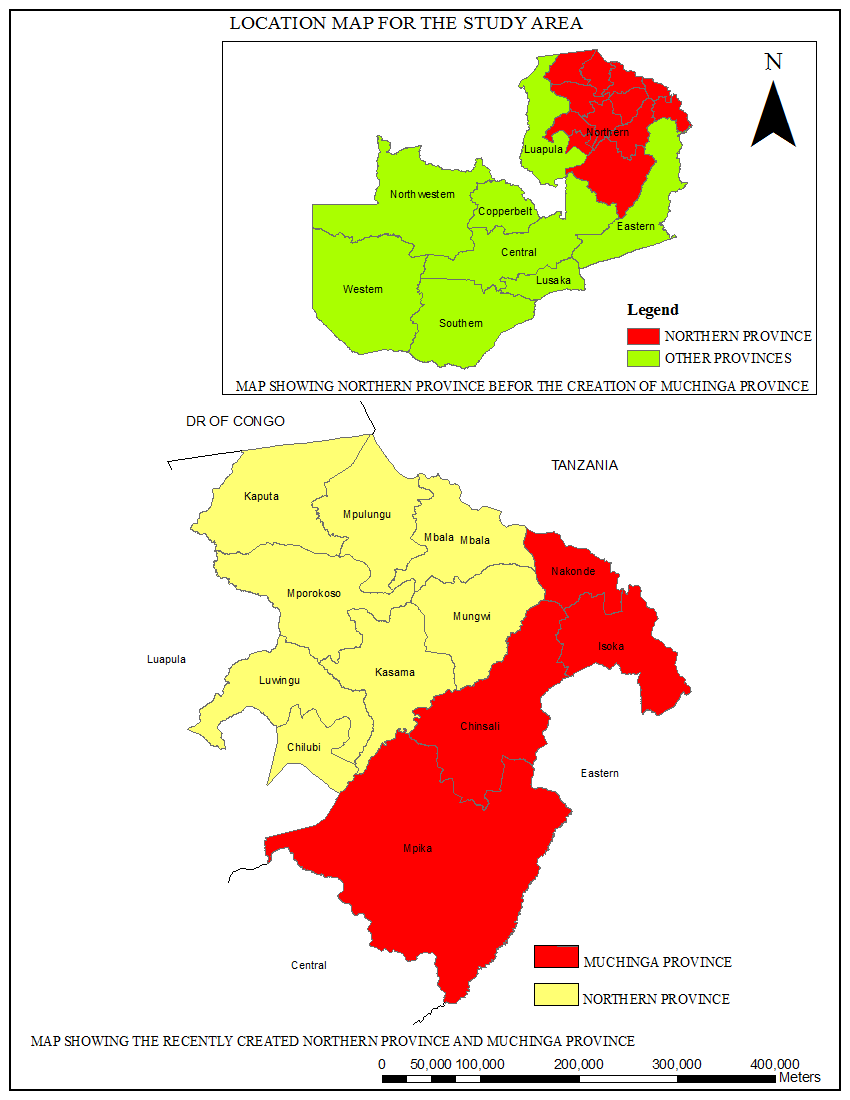 | Figure 2. Map of Northern Province |
6.2. Population and Demographic Characteristics
- The province generally has a low population density[50]. Fifteen tribal groupings inhabit the area, with their various traditional cultural practices and values. The economy of this area is predominantly agricultural based. Farming, fishing and trading are the mainstay of the majority of the population. These activities notably, constitute sources of wealth for most rural dwellers[51].
7. Tourism Resources in the Northern Province
- The Northern Province has a diverse number of tourism resources. These include waterfalls, lakes, wildlife, animal sanctuaries, traditional ceremonies, unspoilt beaches as well as cultural and heritage sites in almost all the districts[52]. Although tourism embraces a very wide range of products, attractions are assets upon which the industry is founded [53,54,55]. Attractions draw tourists, thus creating demand for services that tourism businesses can provide. The list of potential attractions is the starting point, whether attractions are ‘existing’ or ‘created[56]. Figure 3 illustrates the location of tourism potentials and attractions in the various districts of the province.
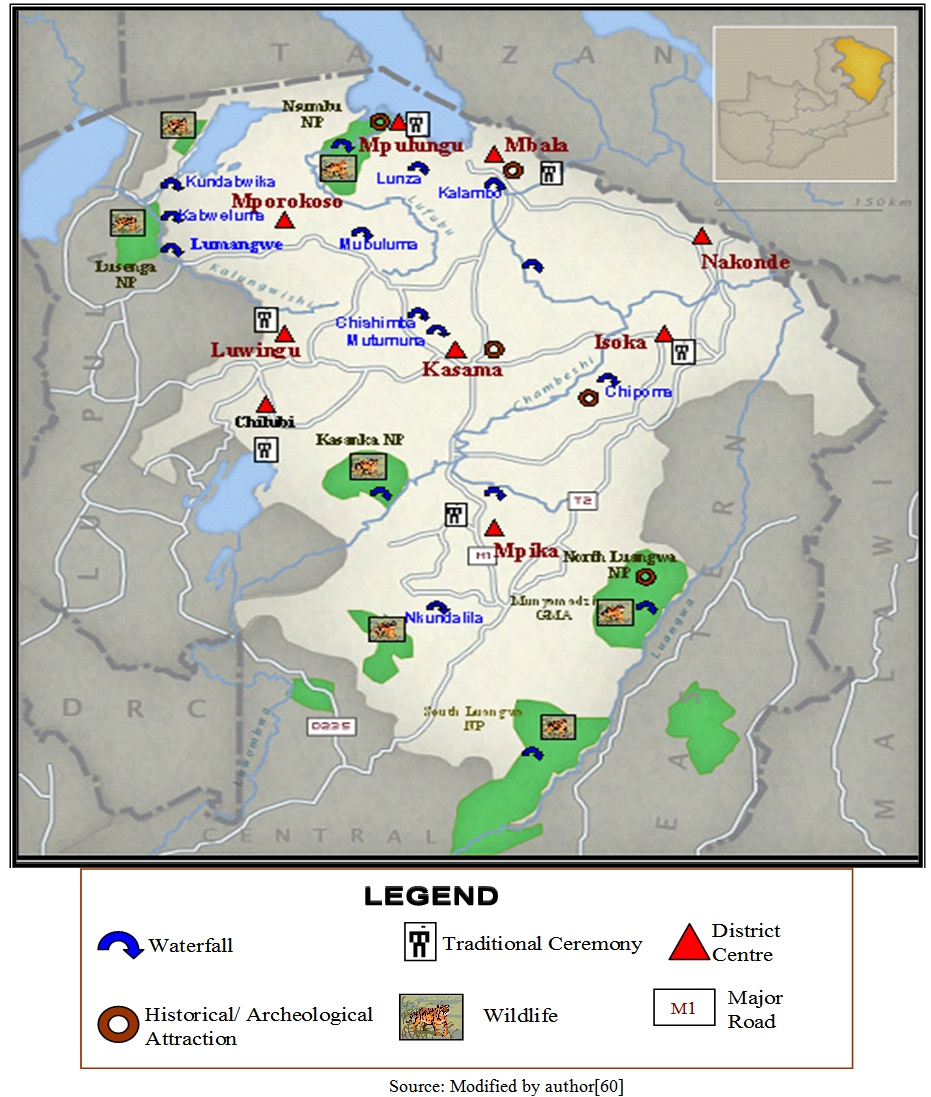 | Figure 3. Northern Province and Tourist Sites |
8. Conceptual Framework
- In this paper, we evolved a conceptual framework that shows the relationship between possible exploitation of tourism potentials in the Northern Province of Zambia, opportunities for tourism development and investments in tourism promotion to generate rural development activities. Figure 4 shows the conceptual framework. The thrust of the framework is that, the possibility of promoting sustainable tourism and rural development in the Northern Province of Zambia would depend upon the political will of the government of Zambia, private investors’ (i.e., both indigenous and foreign investors) preparedness to invest in tourism development activities, by exploiting the tourism potentials of the province. The conceptual framework thus shows the linkage between promotion of sustainable tourism and rural development as a result of investors taking advantage of the potentials and opportunities in the Northern Province of Zambia.The conceptual framework assumes that, the tourism potentials and opportunities are aspects of tourists’ needs and expectations in the rural region which are likely to be exploited to promote sustainable tourism and rural development.
 | Figure 4. Conceptual Framework showing the relationship Between Sustainable Tourism, Tourism Potentials and Opportunities and Rural Development and Source: Developed by the Authors (2007) |
9. Operationalisation of the Concepts in the Framework
- In order to collect the relevant data for the research on tourism development potentials of Northern Province of Zambia, the concepts were operationalized as follows:● Tourism potentials were perceived to be measured as the number of natural waterfalls, the number of heritage sites, sanctuaries and ecological landscape of Northern Province.● Opportunities were perceived to be measured with respect to tourists needs and expectations, the political will of the government of Zambia, and the willingness of private investors (both indigenous and foreigners) to invest in tourism development activities in the Northern province of Zambia.
10. Research Methodology
- Based on the conceptual framework, an empirical study was conducted with respect to the information gathered from inbound and domestic tourists during Zambia’s peak tourism period in the month of July 2007.Since it was an exploratory study, the rationale of the data collection was to ascertain the needs and expectations of both inbound and domestic tourists. One of the major constraints experienced during the study was the inability to identify a large group of tourists in different tourists’ locations within the country at the same time. Thus, tourists were targeted at specific locations. These included Livingstone (the tourist capital of Zambia) because of the tourism development activities associated with the Victoria Falls including curios development centre and market, special game viewing activities, ‘bungi jumping’ and boat cruising. Other locations were Lusaka International Airport and Travel and Tour Agencies. The whole purpose was to ascertain the needs and expectations of tourists based on their experiences. To this effect effort was made to identify both inbound tourists who had visited some attractions in Zambia. In view of the facts given above, we used the non-probability sampling design to collect data from both inbound and domestic tourists. The purposive sampling technique was found to be adequate and appropriate because there was no sample frame of all the tourists who had visited the Northern Province. As a result, the purposive sampling method was adopted. Interview guides and questionnaires were the instruments used for data collection. The interviews and questionnaire administration was made with both domestic and inbound tourists, in addition institutions related to the Zambian tourism industry were also contacted for requisite information and data. To be able to capture a significant number of tourists in the population sample, data was collected from tourists at the Lusaka International Airport departure lounge, local travel agent offices, and popular lodges, tourism enterprises and guesthouses in Livingstone. The research was conducted during Zambia’s tourism peak month of July 2007. A total of 242 questionnaires were filled in. Fifty-seven (57) of the respondents were domestic tourists whilst 185 were inbound tourists. In the case of domestic tourists, Zambian citizens and residents at popular tourist destinations were targeted. Domestic tourism does not have a particular peak season as residents can visit places at various times of the year. The majority were identified as visitors to Livingstone from other cities and towns in Zambia (37 respondents), and 10 respondents from Nsobe camp in Ndola, while 10 respondents had been to Kafue National Park. Notably, the Domestic tourists’ respondents were from cities and towns along the line of rail- where Zambia’s middle-upper classes reside.With reference to tourism investors, nine tourism enterprises (private investors) in Livingstone were selected for the study. The selected tourism enterprises were considered to be able to thrive in rural areas due to their promotion of non-consumptive forms of tourism development. The selection of the nine enterprises was based on their growing popularity among tourists in Zambia. Their outstanding performance prompted the researchers to find out the services that they offer to the tourists.In order to further ascertain whether, meeting tourists’ needs and expectations leads to tangible benefits to local, regional and national economies, the Zambia National Tourist Board and Livingstone Tourism Association (LTA) in Livingstone were identified as key institutions where such information could be obtained.A list of the tourism resources in Northern Province was obtained from the Zambia National Tourist Board Office in Kasama, the National Heritage Conservation Commission in Kasama as well as various tourism websites. Assessments of the effects of Livingstone’s tourism enterprises involved in non-consumptive forms of tourism developments, in meeting the needs and expectations of tourists, were used for comparative analysis. Four categories of questionnaires were administered. One set was designed for domestic tourists, with the others designed for inbound tourists, tourism enterprises in Livingstone that promote non-consumptive forms of tourism, and the Zambia National Tourist Board. The questionnaires for the domestic and inbound tourists focused on obtaining their expectations of Zambia’s tourism resources with regards to marketing the brand slogan of, ‘Zambia - The Real Africa’, as well as information on their preferences and expected needs.The questionnaires to the tourism enterprises focused on obtaining information on how they were able to meet the needs and expectations of tourists in rural areas. The institutional questionnaire designed for Zambia National Tourist Board (currently Zambia Tourism Board) centred on obtaining information on the factors accounting for the successful growth and development of tourismEmpirical Results, Interpretations and Implications: Tourist demand for tourism attractions and resources has provided the impetus for the tourism industry to seek to derive optimum benefits from its interactions with tourists. The empirical results were considered as a basis to formulate the appropriate strategies for the promotion of sustainable tourism for rural development. The main issues discussed are tourists’ needs and expectations, rural areas visited origins and destinations of tourists, experiences of tourists in both rural and urban areas in Zambia.
11. Inbound Tourists and their Needs and Expectations
- Inbound tourism, which deals with visits to a country by non-residents, is important to the tourism sector. It is important to understand that inbound tourists may have different needs and expectations compared to domestic tourists. To attract inbound tourists and meet their expectations, when they arrive in Zambia, it will be necessary to know more about them and understand their needs and preferences[71]. The following data was obtained through the questionnaires:On the issue of first visit to Zambia, the research revealed that, 53.5% out of the 185 respondents were visiting Zambia for the first time. Interestingly, 48% of the same respondents had to stay for only between one to 14 days whilst 70% stayed for a maximum of 21 days. Analysis of the purpose of visit by the inbound tourists to Zambia creates awareness on their needs and expectations to some extent. The responses included visiting family and/or friends in combination with entertainment, participating (or attending) a cultural event, incentive travel sponsored by employer, wildlife viewing in the national parks, leisure – holidays, religious reasons, participation in a conference/ seminar/ training event, business trip, and other reasons. Approximately 59% of the tourists had at least one purpose. However, the frequency distribution shows that tourists have multiple purposes.The four most frequent reasons for tourists visiting Zambia were: wildlife viewing in the national parks and game reserves (27%), religious reasons (24.3%), visiting friends and relatives in combination with entertainment (31.9%), and leisure holidays (23.8%). Interestingly, 85.9% visited the rural communities for a number of reasons. In terms of age group of respondents, the study revealed that, 26% were 25 years and below. This was followed by those between ages 45 and 54 (21.1%). Those between the ages of 25 and 34 were the least (14.7%). The results portrayed that young travelers are adventurous and ready to explore new areas. The least cohorts of ages 25 to 44 represent the working class of national economies. The elderly represented by the two cohorts of ages 45 to 54 and over 55 years (i.e., 40%) are the retired working class members of society. Such tourists have the time and resources to go on holidays.Tourists Destinations Visited by Inbound Tourists: A significant number of foreign tourists have had the opportunity to visit Zambia’s popular tourism destinations with 74.9% visiting Victoria Falls. Other popular destinations included South Luangwa National Park (24.3%), Mosi-O-Tunya National Park (25.4%), Lake Kariba (26.5%) and Other National Parks and Game reserves (26.5%). These destinations are Zambia’s most developed and marketed attractions. The Victoria Falls has been listed as one of the Seven wonders of the World, hence its popularity. It is located in Livingstone, Zambia’s tourist capital, therefore quite a number of tourists oriented amenities have been put in place to cater for the tourists’ needs. Interestingly, not many tourists had the opportunity to visit Zambia’s other attractions and destinations (15.1%). Some of the destinations mentioned under this criteria included the Kalambo Falls, Samfya Beach, Mansa, Chisimba and Mutumuna Falls, Ntumabachushi falls, Mpika, Lake Tanganyika, the Kuomboka ceremony in Mongu. The attractions, on the other hand, have had low publicity and adequate development to promote their tourism potential. This disparity based on skewness of preferences by tourists attest to the point that, not much has been done for the rural communities particularly in the Luapula and Northern Provinces of Zambia, where there is a huge potential for promoting rural tourism. Preferences of Inbound Tourists: The data revealed that inbound tourists to Zambia were interested in visiting Zambia’s diverse tourist attractions. They were least interested in lodging in exquisite hotels and would rather experience the natural, cultural, and historical attractions. Further inquiry on their levels of satisfaction with the various attractions revealed that their expectations where exceeded in terms of Zambia’s natural scenic attractions, local residents’ attitudes’ towards tourists, the availability of adequate accommodation, opportunities to participate in traditional way of life, traditional art exhibitions and traditional ceremonies. Notably 55% of the respondents claimed not to have experienced certain historical attractions. Forty-nine percent (49%) of those who had experienced them rated them worse than they had expected.
12. Comparative Analysis of Domestic Tourists and Inbound Tourists
- Internal tourism consists of visits by residents of a country within their own country[72]. It also includes visits to tourist attractions by expatriates or foreign nationals’ resident and working in the country. Such tourists constitute the domestic tourism market. Domestic tourism redistributes domestic currency spatially within the boundaries of a country. Even though it is very difficult to identify domestic tourists in Zambia, the research managed to identify a few using the purposive sampling method. It was realized that, 93% of domestic tourists had been engaged in some form of rural tourism, in comparison to 85.9% of the inbound tourists. Table 1 highlights the comparisons on purposes of visits between inbound and domestic tourists. Table 2 highlights their tourism preferences. The highest interest was in ‘visiting natural attractions’, and of the least interest was in ‘lodging at Zambian hotels or lodges’. The ‘Total’ figures highlighted in the bottom cells reflect the strength of opinion per attraction preference. This also reflects the ‘Interest Hypothesis’ where respondents who are more interested in the subject of a questionnaire respond more readily, and those who feel strongly about an issue are more likely to respond.[73] Table 3 highlights their interpretation of the prevailing marketing slogan during the study, which was ‘Zambia, the Real Africa’.
|
|
|
|
|
13. Meeting Needs and Expectations
- The evolution of tourist destinations can result from many factors including the rise in demand leading to an increase in supply of services and therefore a proliferation of secondary attractions[74]. Therefore, the strategic incorporation of tourists’ needs and expectations in the development and formulation of tourist products is strongly linked not only to the diversification of tourism products but also to their success. Demand-led product development tends to have minimal risks than the supply led development[75], and therefore can be best suited to a country or region in its early stages of tourism development. Ensuring that supply meets demand, will bridge the gap between the ‘customers’ expected service and managements’ perceptions of customer expectations’[76].In selecting the sites with the highest potential, the research used the following criterion based on the analysis of attractions in the province, and the proximity of potential tourist attractions:● High concentration of scenic sites with aesthetic appeal. ● Availability of major roads leading to the sites. ● District or sub-region of location ought to be able to support other economic activities. ● Proximity to wildlife management areas to compliment wildlife tourism. ● Presence of settlement areas around the sites. ● Features and activities of historical and Cultural Interest. From the criteria, the scenic sites in Mporokoso, Mpulungu, and Kasama were deemed suitable for product development. This is because the destinations are not single, homogenous products, but are a package of a wide range of individual tourism products. They are also part of the current Northern Province[77]. Figure 5 highlights the three prime locations.Product development can be done by recognising the tourism potential of the Province and planning strategically for efficient allocation of funds to intended destinations. The government’s support together with increased private sector investment will create good supporting infrastructure enabling investors to generate profits. Also, since a large proportion of the land in the Northern Province is owned by local chiefs, there is the need for chiefs to work hand in hand with the state in land distribution and to make them stakeholders in tourism development. This will include the community’s participation in the design and decision-making process and in the management and administration of tourism related activities and operations.
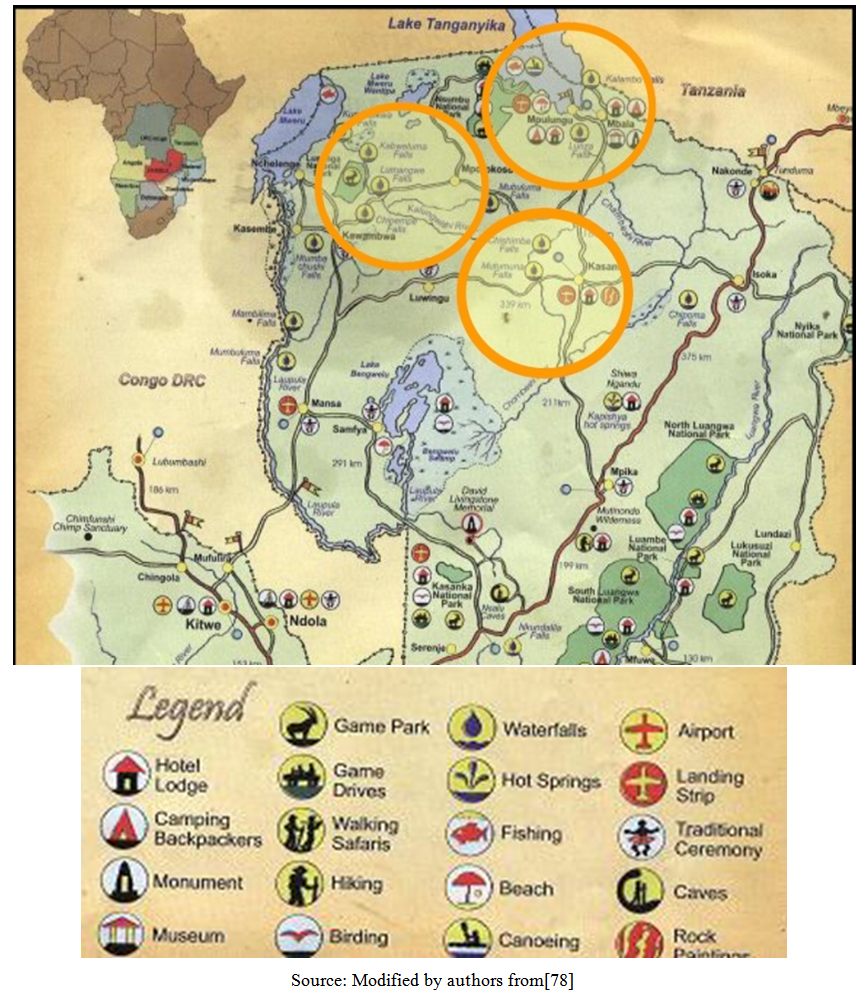 | Figure 5. Prime Locations for Tourism Development |
14. Conclusions
- Based on the analysis it was realized that tourists’ needs and expectations vary. The variations give indications to policy makers on tourism promotion and development, in their product and brand marketing, and service requirements. For a country to achieve its tourism development goals it is important to incorporate tourist needs and expectations. The analysis revealed that a large percentage of inbound and domestic tourists had their expectations exceeded with respect to what they wanted to see in areas that they visited. This could be interpreted as a good strategic opportunity to be utilized by tourism planners and developers. Knowing and taking advantage of these needs and expectations will assist to evolve strategies for tourism development.Furthermore it is evident from the cross variable analysis that tourists are interested in the type of tourist attractions that the Northern Province has the potential to supply. It can therefore be inferred that a market exists for such products.
15. Recommendations
- In order to promote the sustainable development of the tourism potentials in Northern Province through an assessment of the needs and expectations of tourists, we make the following recommendations:Promotion of Domestic Tourism: Domestic tourism has an important role to play as a form of patriotic education, in particular, of the younger generation. The fact that local tourists had the interest in visiting various attractions and desired to have more information on them reveals that the domestic market has great potential. Most tourism promotion campaigns focus on the foreign market thus creating the impression that the local market is not part of the tourism industry. The lack of data on the number of local tourists visiting sites, and the impact that they bring to the destinations, has further marginalized the domestic market. Regular Monitoring of Tourists ‘Satisfaction’ Levels: The creation and development of attractions can be derived from the views and expressions of tourists. Regular monitoring may be costly for private sector businesses in tourism. The Zambia Tourism Board can thus conduct this research to aid the direction of tourism development plans, and tourism promotion of specific areas of national interest. Research work can be conducted in partnership with research institutions such as the public universities with expertise in tourism market research, the hospitality industry, and resource conservation. It can also be conducted at digital level by providing a link on their website which allows visitors to express their views of their trips. Corresponding information can be verified with the management of the different tourists’ attractions visited. With much publicity of such a digital facility, both domestic and inbound tourists can be encouraged to complete their surveys. The final analysis and outcomes of this research will support subsequent development plans and investment decisions by the private sector. Sustainable Development Approach to all Levels of Planning and Development of Tourism Potentials in the Northern Province: Institutions involved in the creation the tourism products of the province should share a common attainable vision for the province. Since the key tourism potentials are natural features of the environment, sustainable development ideals should be upheld by the institutions involved at all levels, and should include focusing on forms of tourism development that centre on resource conservation. These may include, ecotourism, nature based tourism, and cultural tourism.
 Abstract
Abstract Reference
Reference Full-Text PDF
Full-Text PDF Full-text HTML
Full-text HTML